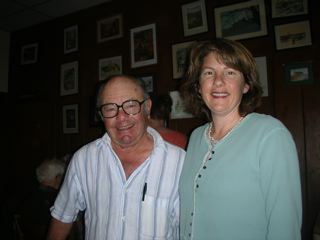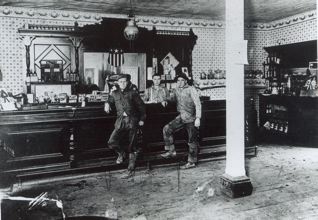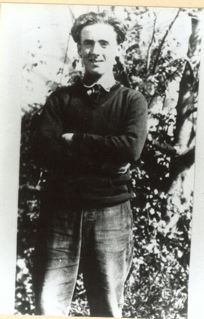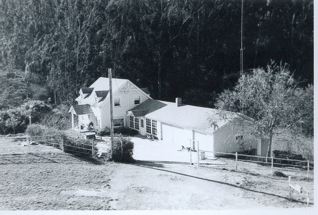(Image courtesy San Mateo County History Museum. The Museum is one of my favorite charities. Please visit the exhibits and archives located in the Redwood City’s historical courthouse, the one with the beautiful dome.]
Had Lunch At Duartes in Pescadero
Perfection: Grown in Pescadero
1898: The Half Moon Bay-Pescadero Tiff: Part III Conclusion
[Note: Please read Parts I & II below]
Upon returning to Half Moon Bay, Roma T. Jackson, the Coast Advocate reporter, punched out an unfriendly story, once again pointing out the poor condition of the cemetery fence at Pescadero–going so far as to predict that the Pescaderans would never replace it. He also tossed in a cruel barb, aimed at the young ladies who planned to raise money for a new fence by sponsoring a dance.
The article incensed the Pescaderans who said Jackson’s article had not reported all the facts.
To present their side, “A and B”–the pseudonym for two Pescadero writers, penned a letter to the San Mateo County newspaper, the Times-Gazette.
Referring to Roma Jackson, “A and B” wrote, [Jackson] “knew that money was being raised for the purpose of building a new cemetery fence. He also knew that the ladies have been working day and night for the [cemetery] fence, and it is an insult to them and to the town…to infer that they care nothing for their dead.”
Later it was revealed that the dance had been canceled when money for the fence suddenly materialized– gifts from generous villagers.
“The new fence was raised,” reported the Coastside Advocate, “…an artistic and stately fence gladdens the eye of the passer.”
But that wasn’t enough…as the Half Moon Bay newspaper editor (as official spokesman for the special group that had visited Pescadero) continued to complain about this and that–now it was the less than friendly reception endured while staying in the tiny Coastside village.
Once again there was a retort from the writers “A and B”. “As for hospitality,” they said, “we must confess that we were very lax in that regard, because we did not know we were expected to show any more courtesies to Half Moon Bay than Half Moon Bay has to us upon former occasions.”
That statement by “A and B” speaks volumes, doesn’t it?
Clearly the trip to Pescadero was a public relations disaster for everybody. While the Half Moon Bay crowd clung to their civic superiority, the crusty Pescaderans (“A & B”) closed the door on the affair with a final statement in the Times-Gazette: “…we wish to say that Pescadero, the gem of the coastside of San Mateo County, invites the people of other places to come and visit us. The hotels are kept by hospitable persons and the townspeople stand ready with open arms to welcome the strangers, but ask that when you leave you tell the truth concerning us, and not cast slurs upon the characters of our young ladies, or upon the town in general.”
1898: The Half Moon Bay-Pescadero Tiff: Part II
But by 1898, what had been dubbed “the Pebble Beach War” was over and the beach was open to everyone–and now that the air had cleared, Half Moon Bay sent some of its concerned citizens on a special mission to see how the Pescaderans had weathered the nasty affair. What they found, they said, was a tense former “war” zone.
The special interest group from Half Moon Bay included Roma Jackson, the Coast Advocate newspaper’s reporter/editor/publisher. Roma never missed an opportunity to exploit a juicy quarrel brewing between the two rivalrous Coastside towns.
Anyone could have predicted that the visit would turn into a nightmare. As usual, the contingent from Half Moon Bay criticized, tsk, tsk, tsk-ed and ridiculed their sister villagers. They could never do anything right.
Finally they zeroed in on a deteriorating cemetery fence north of the village–a fence that the Pescaderans later acknowledged as “the disgrace of our cemetery”. But for now they remained tight-lipped–except to leak the news that funds for a brand new fence were to be raised at an upcoming dance organized by the young ladies in town.
Privately, the Pescaderans thought the condition of the fence was none of Half Moon Bay’s business. They prided themselves on being independent thinkers who resented Half Moon Bay flexing its muscles so far from home.
“If our town does not suit the people of other towns,” sniffed the proud Pescaderans, “our advice to them is to stay away.”
…To Be Continued…
1898: The Half Moon Bay-Pescadero Tiff: Part I
In February, 1898, the villagers of Pescadero had had enough of the stream of unrelenting criticism dished out by a visiting contingent from Half Moon Bay. What was the problem? It was about everything in general, but specifically, the poisonous word darts were aimed at the fence surrounding the local cemetery where some of the gravestones were artfully decorated with stones gathered from nearby famous Pebble Beach.
As soon as the offending party from Half Moon Bay left on the stagecoach, the Pescaderans met and decided to forgo sending a formal thank you along with freshly made olallieberry pies–and instead offered a caustic serving of what was on their minds.
The timing of the visit was unfortunate. The tug-of-war over who owned tiny, precious Pebble Beach had made its way through the courts, subjecting the Pescaderans to ruthless scrutiny in the press. That fiasco had been instigated by the village’s best known resident-villain, the litigious millionaire landowner Loren Coburn.
He said he owned Pebble Beach, treasured as one of the village’s family jewels–an 1898 one-of-a-kind beach attraction that brought horse and buggy tourists and prosperity to quaint Pescadero. Coburn planned to charge an admittance fee and that did not sit well with the locals who were used to roaming about everywhere freely.
To demonstrate his power, Loren Coburn closed the beach sending Pescadero’s fragile economy into a tailspin. Depending on which newspaper you read, the press either wagged a disapproving finger at the Pescaderans or at Coburn, sometimes both, but the upshot of the testy affair was that tourists stopped visiting and spending money in Pescadero.
…To be continued…
…And Greetings From Pescadero…
Meet Pescadero Soccer Player “Mountain Lion” Lloyd Locke (1920s)
J.C. Williamson: Dapper President of Pescadero School District
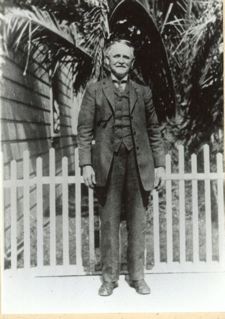
And here’s the list of neighbors who contributed to the “Soccer Field Fund” in the 1920s– for all of you folks interested in who was then living, working and financially supporting the school district in Pescadero.
 The names are: J.C. Williamson, E.R. Pinkham, First National Bank of Pescadero, M. Baptist, Pescadero Inn–B.R. Phillips, Dr. C.V. Thompson, M.V. Martin, Dr. Theo K. Miller, E. Williman, Tony George, J. Goulson, Walter Moore, G.M. Steele, C.E. Steele, R.R. Woodman, N.E. Steele, Ida E. Raney, T. Hayashi, T. Anouda, Fain, Joe Francis, Armando Rossi, R. Morello, Z. Nakashima, Mrs. Mary G. McCormick, Marcella H. Kartheiser, Chas. Scott, H. Harada, Frank Quadro, J.F. Steele, F. Steele, Chas. H. Knapp, Veda Griffiths, Mildred R. Steele, Rufus Steele, John Cardoza, Frank Masamori, Mrs. Ida Mesquite, Miss Sadie Pinkham, Manual Brazil, Frank Pinkham, Julia Vega, Y. Yoshi, G. Seirrizdee, Tachiki, Y. Yamato, Mrs. Joe Baker, G. Kajiako, M. Schroeder, G. Winkler, C.F. Humphrey.
The names are: J.C. Williamson, E.R. Pinkham, First National Bank of Pescadero, M. Baptist, Pescadero Inn–B.R. Phillips, Dr. C.V. Thompson, M.V. Martin, Dr. Theo K. Miller, E. Williman, Tony George, J. Goulson, Walter Moore, G.M. Steele, C.E. Steele, R.R. Woodman, N.E. Steele, Ida E. Raney, T. Hayashi, T. Anouda, Fain, Joe Francis, Armando Rossi, R. Morello, Z. Nakashima, Mrs. Mary G. McCormick, Marcella H. Kartheiser, Chas. Scott, H. Harada, Frank Quadro, J.F. Steele, F. Steele, Chas. H. Knapp, Veda Griffiths, Mildred R. Steele, Rufus Steele, John Cardoza, Frank Masamori, Mrs. Ida Mesquite, Miss Sadie Pinkham, Manual Brazil, Frank Pinkham, Julia Vega, Y. Yoshi, G. Seirrizdee, Tachiki, Y. Yamato, Mrs. Joe Baker, G. Kajiako, M. Schroeder, G. Winkler, C.F. Humphrey.
Let’s Take A Field Trip! [1924]: Part I
 Drawing of Pescadero High’s colors by a Pescadero student, 1920s
Drawing of Pescadero High’s colors by a Pescadero student, 1920s
It was spring 1924 in the tiny village of Pescadero. The cattle grazed peacefully., the brook reflected the clear blue sky and the wild buttercups and daisies competed for attention.
At the high school some 20 students and their three teachers reminisced about the field trip the science class took to the Portland Cement Company’s plant at nearby Davenport, a picturesque coastal village nine miles north of Santa Cruz.
More than a dozen students and Miss Kartheiser, their instructor, had piled into three cars for the ride to Davenport. The road was narrow and not one automobile was encountered.
The day was picture perfect–and Miss Kartheiser stopped the convoy to pick wildflowers for the botany class. Resuming the journey, the caravan headed south–and all went well until there was a sharp crack followed by a discouraging “pfffffttttt.”
…To Be Continued…


